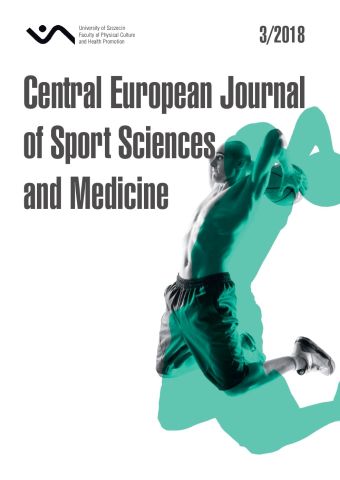
ISSN: 2300-9705
eISSN: 2353-2807
OAI
DOI: 10.18276/cej.2018.3-05




Lista wydań /
Vol. 23, No. 3/2018
Forms of Activities with a Dog as Modern Types of Physical Recreation
| Autorzy: |
Monika
Niewiadomska

Faculty of Physical Education and Health Promotion, University of Szczecin, Poland |
| Słowa kluczowe: | physical activity agility type 1 diabetes dog sports |
| Data publikacji całości: | 2018-09 |
| Liczba stron: | 6 (53-58) |
Abstrakt
The rapid civilisational development that took place in the second half of the 20th century, and the resulting changes in the conditions and ways of people’s lives brought forth a number of social phenomena, both positive and negative. Physical activities, i.e. any forms of physical effort undertaken voluntarily in leisure time for entertainment and health purposes, contribute greatly to overcoming the dangers of modern civilization. Among these, activities with the participation of a dog are becoming increasingly popular. These activities are exercised by people of all ages in the form of dog sports, as well as for recreational and therapeutic purposes.
The aim of the paper is to present various forms of activities with a dog as modern types of physical recreation exercised by people of all ages.
Regular exercise with a dog greatly improves the well-being and provides a feeling of harmony and inner peace. It is becoming yet another modern form of activity.
Pobierz plik
Plik artykułu
Bibliografia
| 1. | Adamowicz, S. (2017). Pies paserski. Retrieved from: http://www.szkolenie.lodz.zkwp.pl/praca-psa-pasterskiego. |
| 2. | Blackwell, E.J., Twells, C., Seawright, A., Casey, R.A. (2008). The relationship between training methods and the occurrence of behavior problems, as reported by owners, in a population of domestic dogs. Journal of Veterinary Behawior, 3, 207–217. |
| 3. | Buss, D. (2001). Psychologia Ewolucyjna. Gdańsk: GWP. |
| 4. | Cantazaro, D.A. (2003). Motywacje i emocje. Poznań: Zysk i S-ka. |
| 5. | Cynarski, W.J. (2017). Czas wolny, turystyka i rekreacja w perspektywie socjologicznej. Kraków: Universitas. |
| 6. | Dencikowska, A., Drozd, S., Czarny, W. (2008). Aktywność fizyczna jako czynnik wspomagający rozwój i zdrowie. Rzeszów: University of Rzeszów. |
| 7. | Ekman, P., Davidson, R.J. (1998). Natura emocji. Podstawowe zagadnienia. Gdańsk: Wydawnictwo Psychologiczne. |
| 8. | Federation CynologiQue Internationale (FCI) (207). Regulamin agility. Retrieved from: www.zkwp-szkolenie.pl/dyscypliny/agility/agility_regulaminy. |
| 9. | Jarosz-Chobot, P. (2006). Epidemiologia cukrzycy typu 1. In: E. Otto-Buczkowska (ed.), Cukrzyca typu 1. Wrocław: Cornetis. |
| 10. | Jaskólski, A. (ed.) (2002). Podstawy fizjologii wysiłku fizycznego. Wrocław: Academy of Physical Education. |
| 11. | Kuński, H. (2002). Trening zdrowotny osób dorosłych. Poradnik lekarza i trenera. Warszawa: AG Medsportpress. |
| 12. | Jastrzębska, A., Gugołek, A., Strychalski, J. (2017). Zwierzęta w sporcie, rekreacji i rozrywce, cz. 1. Wiadomości Zootechniczne, 55 (1), 87–93. |
| 13. | Journal (2013). Of the International Society for Preservation of Primitive Aboriginal Dogs, 35. |
| 14. | Marshall-Pescini, S., Passalacqua, Ch., Barnard, S., Valsecchi, P., Prato-Previde, E. (2009). Agility and search and rescue training differently affects pet dogs’ behaviour in socio-cognitive tasks. Behawior Prosesses, 81, 416–422. |
| 15. | Niewiadomska, M., Radziejewska, M. (2008). Uzasadnienie konieczności wykorzystania wysiłku fizycznego w leczeniu dzieci z cukrzycą typu I. |
| 16. | Pedagogic, Psychology, Medical-Biological Problems of Psyhical Training and Sports, 5, 161–164. |
| 17. | Niewiadomska, M., Radzijewska, M., Horodnica-Józwa, A., Petriczko, E. (2010). Wykorzystanie agility jako formy rekreacji w leczeniu dzieci z cukrzycą typu 1. Pediatric Endokrynolog Diabetes and Metabolizm, 16 (2), 89–93. |
| 18. | Otto-Buczkowska, E., Jarosz-Chobot, P.( 2001). Wpływ wysiłku fizycznego na homeostazę glukozy u osób z cukrzycą. Med. Metabol., 2, 37–41. |
| 19. | Ponikowska, I., Adamczyk, P. (2006). In: Otto-Buczkowska (ed.), Wysiłek fizyczny – ważny element leczenia cukrzycy typu 1. Cukrzyca typu 1. Wrocław: Cornetis. |
| 20. | Sas-Nowosielski, K. (2003). Wychowanie do aktywności fizycznej. Katowice: Academy of Physical Education. |
| 21. | Schilder, M.B.H., Van der Borg, J.A.M. (2004). Training dogs with help of the shock collar: short and long term behavioural effects. Applied Animal Behaviour Science, 319–334. |
| 22. | Skarżyński, J. (2003). Biegiem po zdrowie. Szczecin: Mega Sport. |
| 23. | Solomon, R.L.,Wynne, L.C. (1953). Traumatic avoidance learning: acquisition in normal dogs. Psychol. Monogr., Gen. Appl., 67 (4),1–19. |
| 24. | Ziemian, P. (2018). Flyball. Retrieved from: https://pl.wikipedia.org/wiki/Flyball. |